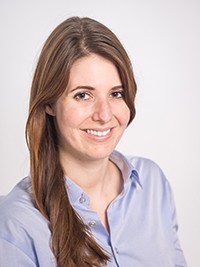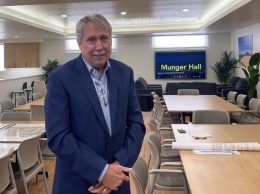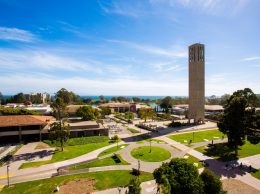UCSB’s newest scholar is living in a material world
IN THIS ARTICLE
- Columns Topic
- Erika Martin Author
By Erika Martin Friday, February 6th, 2015

Erika Martin
UC Santa Barbara changed the face of leadership at its world-class STEM departments this week, naming alumna Rachel Segalman the Edward N. Kramer Chair of Materials & Chemical Engineering.
While the appointment does not put Segalman at the helm of either department, her endowed, joint seat in two of the university’s highest-profile departments marks a shift from the old guard. Among the university’s 20 chemical engineering faculty members, Segalman is one of three women. And in materials, women are three of 28, including department chair Tresa Pollock. Those figures would be even more lopsided if the departments’ male-only emeriti and adjunct faculty were counted.
The position was created following the unexpected death of 75-year-old professor Kramer on Dec. 27. Kramer joined the university’s materials and chemical engineering staff in 1997, when he was recruited out of a 30-year career at Cornell University.
When Segalman arrived on campus the next year, Kramer recognized her brightness and enlisted her to help build his lab. She later became the first student to graduate from his group.
Kramer and his wife donated enough money to the university to establish an endowed chair, and it seems only fitting that the talent harvested by the late professor pick up where he left off. Kramer was scheduled to teach an undergraduate chemical engineering course this quarter, Introduction to Polymer Science, that Segalman has now taken under her wing.
In a video interview with Segalman produced by the UCSB College of Engineering, she said her return to campus was “a lot like going somewhere new and exciting with CliffsNotes” given how much has changed since she earned her Ph.D. in 2002.
“There has been an enormous amount of growth on campus in the buildings, in the faculty and in the people, and it’s really exciting,” she said.
Upon graduating from UCSB, Segalman studied as a postdoctoral fellow at Universite Louis Pasteur in Strasbourg, France, where she worked on conjugated polymer synthesis. She then spent a decade at UC Berkeley as an associate professor of chemical engineering and a faculty scientist in the materials science division at Lawrence Berkeley National Laboratory.
There, Segalman worked to control the structure and thermodynamics of functional polymers and designed polymeric and hybrid materials for use in thermoelectric, photovoltaic and solar energy systems.
Though Segalman comes from a long line of chemists and chemical engineers, she entered her freshman year at the University of Texas at Austin as a pre-med major. But once classes began, her roots suddenly came to the surface.
“My great-grandmother was one of eight siblings, five of whom were chemical engineers, and my mother and both of her sisters and brother are either chemists or chemical engineers,” Segalman said in the video interview. “This wasn’t really a pressure thing where I thought I had to do this growing up, but rather when I hit college … I discovered I loved chemistry and I loved the problem-solving aspect of chemical engineering. I liked the way the chemical engineering background got me to think molecularly about materials.”
Her research efforts at UCSB will continue in the same vein of Kramer’s innovative work in the self-assembly of functional polymer systems, which led to advancements in the manufacturing and functionality of products such as semiconductors and microprocessors.
Segalman said she likes to look at how a polymer’s molecular through mesoscopic structure affects its properties, research that can yield a broad range of practical applications across industries.
“We’re interested in a lot of properties right now, many of them energy related,” she said. “We have projects in thermoelectrics that convert heat to energy, [and] we have some in more traditional conducting polymers, ion conducting polymers and even anti-fouling coatings for ships that help you prevent bringing invasive species across the Pacific.”











